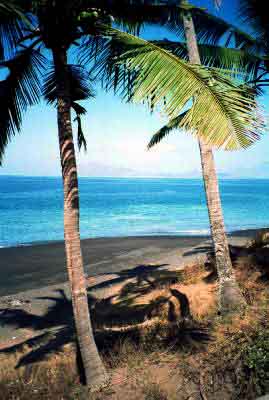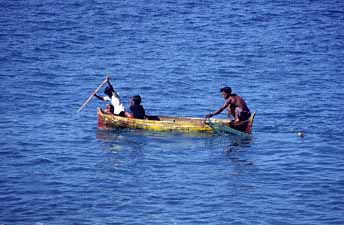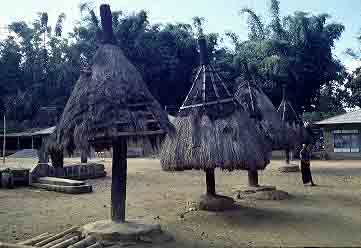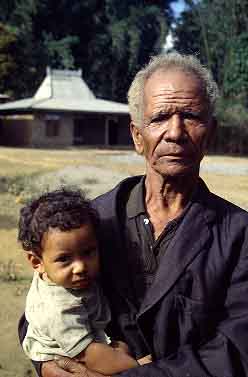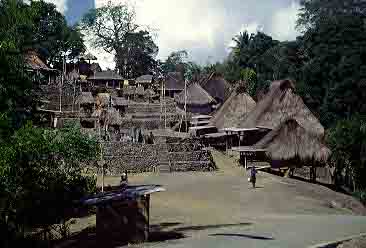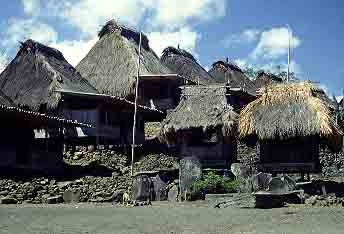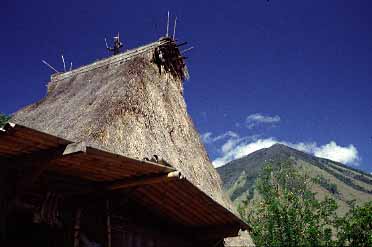|
|
|
REF: IND/016
|
REF: IND/017
|
The next morning, I left hospitable Moni and began a journey to the central part of Flores. The bus was very crowded as usual. Public transport in Indonesia was relatively cheap and it was virtually the only way to move around. In almost every village, passengers traded places and each bus stop was turned into a small bazaar. The road mainly followed a wide river valley, winding around cultivated fields and banana plantation. Two hours later the road approached the coast and I reached Ende, the biggest town on Flores and capital of the island. It was also the most important port for the whole region. |
|
|
REF: IND/018 |
REF: IND/019 |
The town had a very beautiful location at the foot of several volcanoes. The most famous of them was Gunung Meja with an almost perfectly conical shape and a flat summit. Another volcano, Gunung Ipi, a little bit further south, was still considered active. Waiting for another bus, I could admire a beautiful view of tropical beaches with black, volcanic sand and coconut palm trees bowing to the sea. |
|
In Bajawa District, 60,000 Ngada people were living on a large plateau where Bajawa is located and also on the southern slopes of the volcano Inerie. The Ngada were the most well known ethnic group of Flores because they had preserved, far better than most, their unique culture, customs and traditional architecture. Almost all Ngada people were Roman-Catholic, but at the same time, they also practiced their ancient animistic beliefs. Bajawa was the tourist centre of the whole region and jumping off point to the neighbouring traditional Ngada villages. |
|
|
|
REF: IND/020
|
REF: IND/021
|
The first of the villages, Langa was located just a few kilometres from the town. It was also very typical. The main square of the village contained two characteristics for Ngada cultural elements: five nghadu and four bhaga. Nghadu were similar to umbrellas in structure, consisting of a three-meter long stick and a reedy roof. A small statue of a man toped them, often with a headband, holding a parang (machete) in one hand and a spear in the other one. A Bhaga was a miniature of a house with the steep roof. The meaning and function of nghadu and bhaga were various but first of all they were supposed to symbolise the presence of ancestors. The nghadu was always masculine and bhaga feminine, and each pair belongs to a particular family group living in the village. The carved sticks of nghadu were always very solid like a rock; however, their top parts were often in poor condition. It was said that some of them have been carved to commemorate people killed during ancient land disputes and were more than 100 years old. The main trunk of a nghadu, called Sebu, must had come from a special type of wood and must had been dug out together with its roots, transported to the village along a direct line, and planted in a specific place. |
|
|
|
REF: IND/022 |
REF: IND/023 |
Another village, Bena was located 10 kilometres further south of Langa. A narrow road winded to the foot of the perfect cone of the extinct volcano Inerie (2245m). Bena was the most typical and best preserved of all villages in the area and consisted of two rows of houses with tall, steep rectangular roofs supported by two sticks. There was an empty space between them containing several nghadu, bhaga, and mysterious megalithic structures. The whole complex rose gradually up the hill. |
|
|
|
REF: IND/024 |
REF: IND/025 |
|
|
REF: IND/026
|
REF: IND/027 |
More pictures from Indonesia
Indonesia - Table of Contents
© Jacek Piwowarczyk, Indonesia 1993 |

